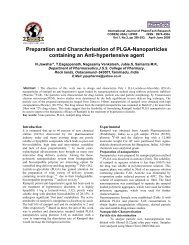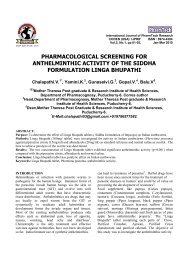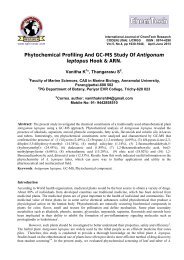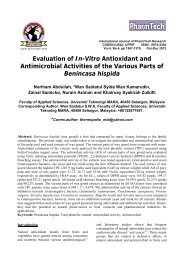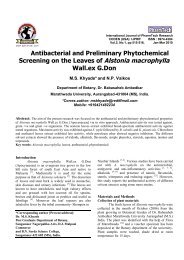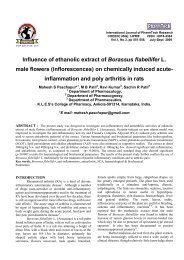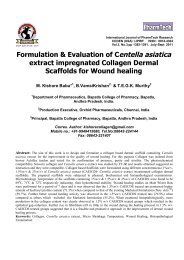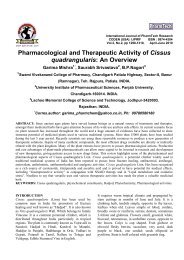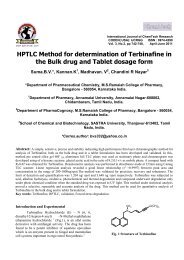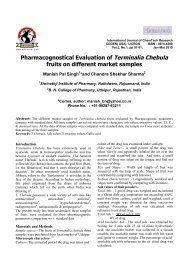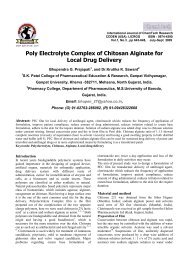epoxidation of wild safflower (carthamus oxyacantha) - Research ...
epoxidation of wild safflower (carthamus oxyacantha) - Research ...
epoxidation of wild safflower (carthamus oxyacantha) - Research ...
Create successful ePaper yourself
Turn your PDF publications into a flip-book with our unique Google optimized e-Paper software.
Pawan D. Meshram et al /Int.J. ChemTech Res.2011,3(3) 1155<br />
being taken after one hour since zero time. The<br />
collected samples were washed with warm water<br />
successively to make them acid free and extracted with<br />
diethyl ether in a separating funnel to enhance the<br />
separation <strong>of</strong> the oil product from water phase and<br />
dried using a rotary evaporator. The progress <strong>of</strong><br />
<strong>epoxidation</strong> was monitored by determination <strong>of</strong><br />
oxirane content and iodine value <strong>of</strong> the washed<br />
aliquots <strong>of</strong> the reaction mixture. Two replication <strong>of</strong><br />
each experiment were performed alongside to<br />
determine the percentage deviation between two<br />
experimental results and the deviation was found to be<br />
less than 5%.<br />
Analytical methods<br />
Acid value, Saponification value, Iodine value and<br />
Specific gravity <strong>of</strong> the raw WSO were determined<br />
according to AOCS Method Cd 3d-63, AOCS Method<br />
Cd 3-25, AOCS Method Cd 1b-87 and MS 817:1989<br />
respectively. The percentage <strong>of</strong> oxirane oxygen<br />
content was determined using AOCS Official Method<br />
Cd 9-57 (1997) under which the oxygen is titrated<br />
directly with hydrogen bromide solution in acetic acid.<br />
The conversion <strong>of</strong> double bonds to oxirane rings were<br />
observed under FTIR spectra, measured on Shimazdu<br />
FTIR-8400spectrometer equipped with DLATGS<br />
detector and a KBr beam splitter into the range <strong>of</strong> 4000<br />
to 400 cm −1 . The absorbance spectra for each analysis<br />
were averaged over 32 scans with a nominal 4 cm −1<br />
resolution.<br />
From the oxirane content, the percentage relative<br />
conversion to oxirane was determined using the<br />
following formula [3] :<br />
Relative conversion to oxirane (RCO)<br />
= [OOex / OOth] × 100 ----------------------------(1)<br />
where OOex is the experimentally determined content<br />
<strong>of</strong> oxirane oxygen and OOth is the theoretical<br />
maximum oxirane oxygen content in 100 g <strong>of</strong> oil,<br />
which was calculated to be 8.90% using the following<br />
expression [24] :<br />
OOth = {(IVo / 2Ai) / [100 + (IVo / 2Ai) × Ao]}<br />
× Ao × 100 ----------------------------(2)<br />
where Ai (126.9) and Ao (16.0) are the atomic weights<br />
<strong>of</strong> iodine and oxygen respectively and IVo is the initial<br />
iodine value <strong>of</strong> the oil sample.<br />
RESULTS AND DISCUSSION<br />
The properties <strong>of</strong> WSO, with fatty acid composition,<br />
were analyzed as follows: specific gravity = 0.922 (at<br />
25 o C); acid value (mg KOH/g) = 2.2; iodine value (g<br />
I2/100 g) = 155; saponification value (mg KOH/g) =<br />
194; oleic acid, C 18: 1 = 13%; linoleic acid, C18:2 =<br />
73%.<br />
Effect <strong>of</strong> carboxylic acid<br />
In situ <strong>epoxidation</strong> reactions were carried out with<br />
both formic acid and acetic acid as carboxylic acids;<br />
with and without catalyst reagent with 1:0.5:1.5 molar<br />
ratio <strong>of</strong> ethylenic unsaturation: carboxylic acid:<br />
hydrogen peroxide at a temperature 60°C. The<br />
variations <strong>of</strong> iodine values with reaction time for<br />
<strong>epoxidation</strong> <strong>of</strong> WSO with acidic ion exchange resin<br />
IR-122 as catalyst is shown in Fig.2. The mechanism<br />
<strong>of</strong> double bond conversion to epoxy ring in<br />
[25]<br />
<strong>epoxidation</strong> reaction as proposed by Gan et.al. is<br />
as follows:<br />
The excess reagents can react with the epoxy rings to<br />
cause unwanted side reactions as depicted below [1] :<br />
From Fig.2 it can be shown that the relative conversion<br />
<strong>of</strong> ethylenic unsaturation is faster in presence <strong>of</strong> acetic<br />
acid than formic acid and addition <strong>of</strong> catalyst improves<br />
the rate <strong>of</strong> reduction <strong>of</strong> iodine value (IV). With formic<br />
acid/IR-122 combination, a slightly elevated reduction<br />
in IV is achieved as compared with the use <strong>of</strong> acetic<br />
acid with no resin. Fig.3 shows the relative percentage<br />
conversion to oxirane as function <strong>of</strong> time, from which<br />
it is inferred that formic acid/IR-122 combination is<br />
less effective than acetic acid and acetic acid/IR-122<br />
combination towards ethylenic unsaturation<br />
conversion to oxirane. The 65.4% conversion to<br />
oxirane was obtained for formic acid/IR-122 after 8<br />
hours while with acetic acid the conversion was 72%.<br />
Acetic acid/IR-122 combination resulted into 85%<br />
conversion to oxirane with corresponding iodine<br />
conversion <strong>of</strong> 87.2% was considered a better<br />
combination for <strong>epoxidation</strong> <strong>of</strong> WSO with aqueous<br />
hydrogen peroxide. Further experiments were,<br />
therefore, carried out with acetic acid/ IR-122 to study<br />
the effect <strong>of</strong> various parameters on conversions to<br />
oxirane oxygen and the conversion <strong>of</strong> iodine value.



